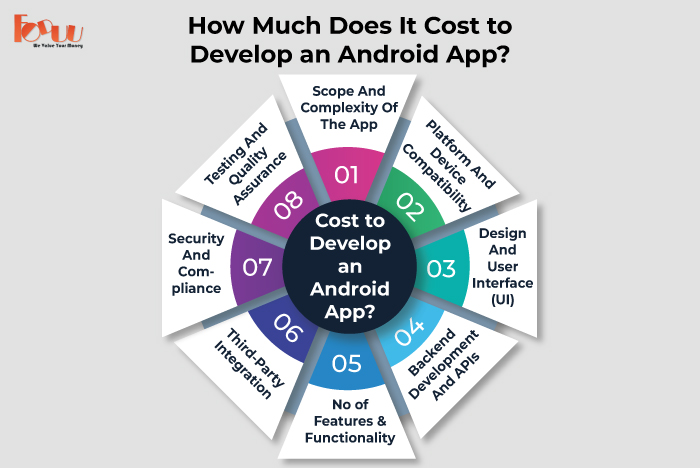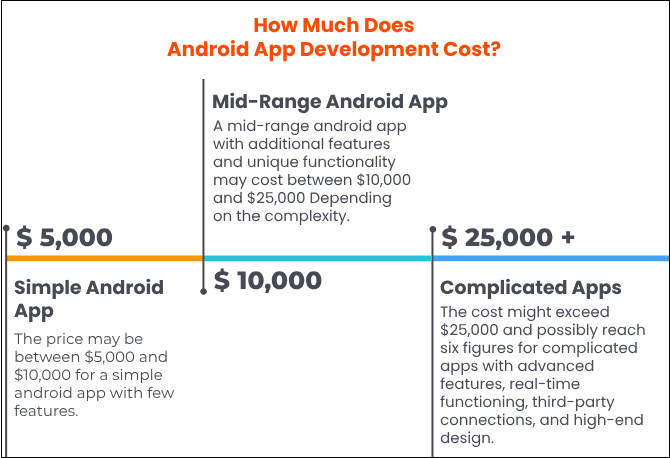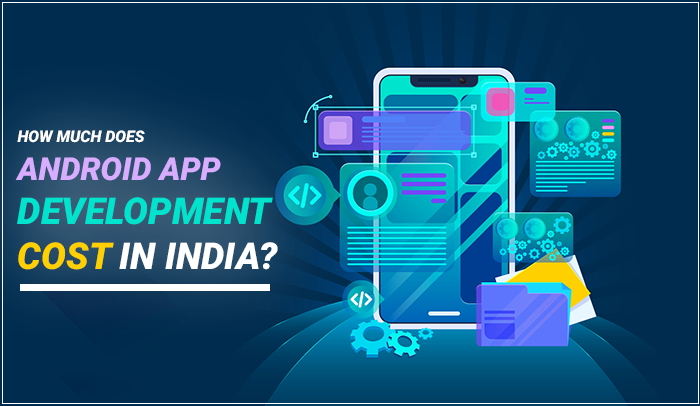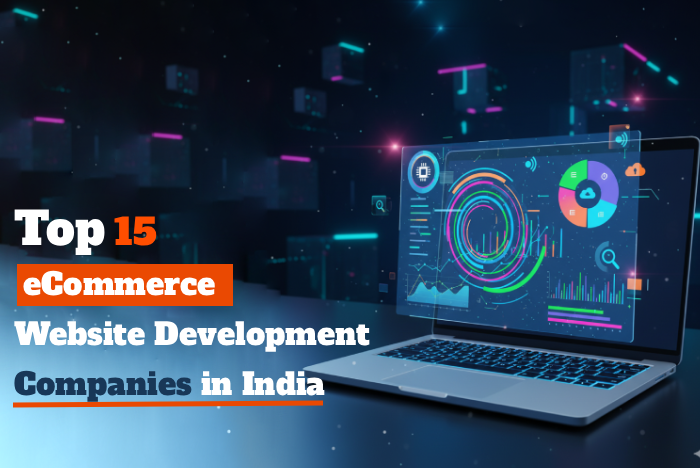The demand for mobile applications increased substantially during recent years as enterprises from different sizes implemented mobile solutions. The country emerged as a leading destination for Android app development mainly because it holds an extensive workforce of skilled developers and offers economical development services.
The global mobile app revenue achieved $693 billion in 2021 according to Statista reports and analysts predict it will expand substantially during upcoming years. The lower rate of Android app development expenses in India compared to Western nations makes India the main choice for businesses looking to outsource their mobile app projects.
The purpose of this guide is to clarify how prices are set, why android developers do it and also enable one to get an idea about the Avg cost of android app development in India of each type of an application.
What is Android Application Development?
Android app development entails the working out or the occurrence of software applications that take place on gadgets informing the Android running operating system. Such devices are smart phones, tab, wearable (day to day wearables as in the case of smart watches), smart television, even in-car entertainment system. Developers usually use programming languages like Kotlin or Java to create software, Android Software Development Kit (SDK), and such tools as Android Studio (the official Integrated Development Environment (IDE) used in software development).
The essence of android app development is establishing applications that are:
Android specific: Designed and optimized specifically to work the Android platform, taking advantage of the features of this platform, and giving the maximum performance and exposure to the users.
User-Centric: Prioritizing intuitive User Interface (UI) and smooth User Experience (UX) to make it easy to use and highly engaging.
Functional: Enabling different features, ranging from simple data presentation to sophisticated integrations such as AI, augmented reality (AR), real-time communications, and secure payment systems.
Scalable: Capable of supporting growing numbers of users and data without sacrificing performance.
An Android App Development Company in India offers end-to-end android application development services, starting from conceptualizing and designing to coding, testing, deployment, and post-launch support.
Importance Of Android app Development in Businesses in Today's World
The importance of Android application development for companies in 2025 cannot be overemphasized. Here's why it's an essential investment:
Huge Market Access: Android commands the largest part of the world's smartphone market. Building an Android app immediately exposes companies to billions of potential customers globally, including a large chunk of India's market.
Heterogeneous Device Infrastructure: Android is supported by a vast range of devices from numerous vendors, across a range of prices and segments. This extensive compatibility provides companies with access to a heterogeneous customer base.
Increased Customer Engagement: Mobile apps offer a direct and personalized platform for businesses to engage with their customers. Push notifications, in-app messages, and personalized content create more meaningful relationships and loyalty.
Increased Brand Visibility & Loyalty: A functional and well-designed app keeps your brand top-of-mind on the home screens of users, building brand recognition. Smooth user experiences result in increased satisfaction and repeat business.
New Streams of Revenue: Apps can be revenue-generating through in-app purchases, subscription plans, advertisements, or by selling goods and services directly (e-commerce apps).
Data Gathering & Analysis: Apps yield rich data on user behavior, trends, and demographics. This information can be used for targeted marketing, product refinement, and business strategy optimization.
Competitive Edge: With a growingly digital environment, companies that are not well-represented on mobile phones are in danger of losing ground to competition. A well-crafted Android app can set a company apart and make a real difference.
Operational Effectiveness: Company-internal Android apps have the ability to simplify business processes, mechanize operations, enhance communication between employees, and boost productivity (e.g., field service apps, inventory apps).
Integration with Advanced Technologies: Android's openness and strength of its SDKs make it easy to integrate with advanced technologies such as AI/ML, IoT, AR/VR, and blockchain to enable companies to innovate and provide futurist experiences.
Factors that Influence Cost of Android App Development in India
The android app development cost in India is not a static amount. It's a variable number that is impacted by a number of interdependent factors. Knowing these factors is important for companies to plan and set expectations while hiring an Android App Development Company in India.
1. App Complexity and Features
Simple Apps (MVP): These are minimal apps with basic functionalities.
Features: User login registration (email-based), static pages (About Us, Contact), minimal search function, push notifications, plain data display. No heavy backend or third-party integration.
Examples: Simple calculator, plain content viewer, run-of-the-mill business card app.
Cost Impact: Minimum, since development time is less.
Medium Complexity Apps: Such apps have more dynamic interactions and integrations.
Features: Custom user profiles, social media integration, payment gateway integration (Razorpay, Stripe), GPS/location services, basic real-time chat, admin panel, API integrations (weather, news feeds), moderate database interactions.
Examples: Simple e-commerce store, simple booking app, basic social media app, utility app with data processing.
Cost Implication: High, involving additional expert-level development and server-side work.
Enterprise-Grade / Complex Apps: Extremely advanced apps with rich features, intricate logic, and high scalability needs.
Features: Advanced AI/ML features (recommendation engines, chatbots), AR/VR support, real-time data synchronization between devices, video/audio streaming, complex animations, custom API implementation, IoT device integration, advanced security features (biometric authentication, encryption), multi-language support, advanced analytics dashboards, custom user roles and permissions, blockchain support.
Examples: On-demand service applications (such as Uber, Zomato), high-level social networking applications, sophisticated gaming applications, fintech applications, integrated healthcare systems (integration of EHR).
Cost Impact: Maximum, requiring extensive development time, specialist skills, and strong infrastructure.
2. Design and User Interface (UI)/User Experience (UX)
Standard UI/UX: Using pre-determined Android Material Design guidelines and default UI components. It is quicker and less expensive.
Custom UI/UX: Creating distinctive, branded user interfaces with custom icons, illustrations, animation, and complex user flows. It involves specialized UI/UX designers, several design rounds, and front-end development time to execute detailed visuals.
Complex Animations & Graphics: Apps featuring rich animations, 3D graphics, or advanced interactive elements demand specialized design and development skills, increasing the android app price.
3. App Platform (Native vs. Hybrid vs. PWA)
Native Android App Development: Building exclusively for Android using Kotlin or Java.
Pros: High performance, access to all device features, utmost security, best possible user experience following Android standards.
Cons: More expensive as it's for one platform, more time-consuming for development.
Cost Impact: Usually the highest for each platform.
Hybrid App Development (e.g., Flutter, React Native): Creating one codebase that can be run on both Android and iOS.
Advantages: Quicker development, lower up-front android app development cost in India (one codebase for two platforms), broader reach of audience from day one.
Disadvantages: Will have some performance compromises relative to native, potentially less access to some esoteric native device capabilities, and occasionally less "native" experience.
Cost Impact: Moderate, usually seen as cost-saving for purposes of multi-platform presence.
Progressive Web Apps (PWAs): Web apps optimized to resemble and behave like native apps, accessed through a web browser.
Advantages: Extremely low development cost, no submission to app store necessary, available immediately.
Disadvantages: Restricted offline functionality, limited access to native device functionality, performance dependent on browser.
Cost Impact: Lowest, but at the expense of function.
4. Development Team Location and Size
Geographical positioning is important when it comes to hourly charges. India has very competitive prices as compared to Western nations.
Hourly Rates in India (approx. for 2025):
Junior Developers (1-3 years experience): ₹1,000 - ₹3,500 ($12 - $42 USD) per hour
Mid-Level Developers (3-6 years experience): ₹3,500 - ₹8,500 ($42 - $102 USD) per hour
Senior Developers (6+ years experience): ₹8,500 - ₹18,000+ ($102 - $215+ USD) per hour
Team Size: A sophisticated app requires a bigger, multidisciplinary team (e.g., Project Manager, UI/UX Designer, Android Developers, Backend Developers, QA Engineers, Business Analysts). For a simple app, maybe only a few developers and a designer are required. The larger the team, the higher the total costs.
Engagement Model:
Fixed Price: Ideal for small projects with well-defined, fixed requirements. Provides cost predictability.
Time & Material: Best suited for complex projects with changing requirements. Provides flexibility but the overall cost may be less certain.
Dedicated Team: Outsourcing your entire project to a full team, providing maximum control and integration, best for long-term or extremely complex applications.
5. Backend Infrastructure & API Integrations
Database Complexity: Database choice (SQL, NoSQL) and data model complexity.
Server Architecture: Scalability demand, choosing cloud services (AWS, Google Cloud, Azure, Firebase) and their setups.
API Integrations: Integration with third-party services such as payment processing gateways (Stripe, Razorpay), social media APIs, mapping (Google Maps), SMS/email gateways (Twilio, SendGrid), and analytical tools. Each integration incurs development time and possibly recurring license costs.
6. Maintenance and Post-Launch Support
Bug Fixing & Performance Optimization: Resolving issues that are encountered in live environments.
OS Updates & Compatibility: Maintaining the app to be functional and optimized with latest Android OS versions and device models.
Feature Enhancements: Incorporating new features as per user feedback, market trends, and competitive analysis.
Security Patches: Addressing vulnerabilities and protecting data privacy.
Tracking: Employing tools to monitor app performance, crashes, and user interactions.
Common Maintenance Cost: Usually between 15-20% of the initial development expense each year.
7. App Category and Industry Details
Healthcare/Fintech Applications: Need rigorous security (e.g., HIPAA compliance, data encryption), regulatory compliance, and typically integrations with already complicated systems, adding a huge amount of development and testing work.
Gaming Applications: Ranging from simple 2D casual games to extremely complicated 3D multiplayer ones, with costs changing wildly depending on the graphics, physics engines, and server infrastructure.
E-commerce/Marketplace Applications: Involving complicated product catalogs, inventory control, secure payment gateways, order tracking, and user review systems.
On-Demand Services Apps: Have real-time tracking, sophisticated matching algorithms, multi-sided platforms (user, provider, admin), and may require substantial backend development.
8. External Integrations and Licensing Fees
Premium APIs: Some advanced APIs (e.g., for specific AI features, specialized data feeds) may include usage-based fees or paid subscriptions.
Licensed Tools/Libraries: Certain development tools or proprietary libraries may be license-requiring.
App Store Developer Fees: Google Play Console has a one-time registration fee of $25 (around ₹2,100 INR as of 2025).

How Much Does Android App Development Cost in India?
Without project details, it is impossible to provide an exact, singular figure for Android app cost in India. However, we can provide a roughly estimated range based on the complexity of apps and the factors explained above. These are approximate for mid-2025.
General Range for Android App Price in India:
Simple Apps (MVP): ₹3,00,000 to ₹15,00,000 (approx. $3,600 - $18,000 USD)
Medium Complexity Apps: ₹15,00,000 to ₹40,00,000 (approx. $18,000 - $48,000 USD)
Complex / Enterprise-Grade Apps: ₹40,00,000 to ₹1,50,00,000+ (around $48,000 - $180,000+ USD)
1. Simple Android App Development Cost in India
Features: Basic UI, login (email/social), static content, contact forms, push notifications, minimal backend.
Development Hours: 200 - 500 hours
Estimated Cost: ₹3,00,000 - ₹10,00,000 (around $3,600 - $12,000 USD)
Timeline: 1-3 months
2. Cost of Medium Complexity Android App Development in India
Features: Custom UI/UX, user profiles, advanced search, payment integration, GPS, real-time chat (basic), admin panel, multiple API integrations, moderate database management.
Development Hours: 500 - 1000 hours
Estimated Cost: ₹10,00,000 - ₹40,00,000 (approx. $12,000 - $48,000 USD)
Timeline: 3-6 months
3. Cost of Complex / Enterprise Android App Development in India
Features: Custom UI/UX with high customization, complex animations, AI/ML features, AR/VR, real-time data synchronization, video streaming, robust backend with multiple databases, IoT integration, advanced security, complete analytics, multi-language support, custom user roles.
Development Hours: 1000 - 2500+ hours
Estimated Cost: ₹40,00,000 - ₹1,50,00,000+ (approximately $48,000 - $180,000+ USD)
Timeline: 6-12+ months
Cost Breakdown by Development Phases (Approximate Percentages of Total Cost)
Knowledge about the budgetary expenditure during various phases aids in realistic planning. An Android App Development Company in India would generally have these phases:
Discovery & Strategy (10-15%):
Activities: Market research, competitor analysis, requirement gathering, technical feasibility, project roadmap creation.
Cost Component: Business analysts, project managers.
UI/UX Design (15-25%):
Activities: Wireframing, prototyping, mockups, user flow design, visual design.
Cost Component: UI/UX designers.
App Development (Frontend & Backend) (50-60%):
Activities: Coding, feature implementation, API development, database setup, server logic. This is the main bulk of the android app price.
Cost Component: Android developers, backend developers.
Quality Assurance (QA) & Testing (10-15%):
Activities: Functional testing, performance testing, security testing, usability testing, bug fixing.
Cost Component: QA engineers, testers.
Deployment & Launch (2-5%):
Activities: App store optimization (ASO), app store submission, final checks.
Cost Component: Project manager, ASO specialists.
Post-Launch Maintenance & Support (Ongoing Annual Cost):
Activities: Bug fixing, OS upgrades, security updates, performance tracking, minimal feature enhancements.
Cost Component: Developers, support staff.

Conclusion
How much does Android app development cost in India is a complex question with no single, simple answer. The android app price is a direct representation of your app's complexity, features, design complexity, the technology stack used, the size and location of your development team, and maintenance requirements.
India is a very appealing place for Android App Development with an excellent combination of affordability and quality android app development services. Knowing the different factors affecting the cost of android app development in India, companies can plan their mobile approach with more sophistication and confidence.
For an accurate estimate for your specific project, it's essential to clearly outline your app vision, features, and audience. Approaching a trustable Android App Development Company in India will make it possible for you to get an elaborate proposal customized according to your requirements, making the process from idea to successful Android application transparent and fruitful.
Although the Avg cost of android app development in India may vary from a few lakhs to more than a crore, the smart investment in an efficiently developed app can bring substantial returns by way of market penetration, customer interaction, and business expansion in the competitive digital world of 2025 and later.
FODUU: Your Trusted Partner for Android App Development in India
FODUU is an android app development company in India Crafting Innovative Android Apps for Businesses Worldwide. Transform Your Ideas into Reality with FODUU's Affordable Android App Development Services.
We provide competitive prices without sacrificing quality because of a dedication to cost effectiveness. Excellence in design, functionality, and user experience are our top priorities from conception through implementation.
You can depend on us to turn your concepts into user-friendly, feature-rich Android applications that appeal to your target market. With the help of our first-rate development services, improve your mobile presence. We put an emphasis on your achievement.
Contact us or call us at +91 881 730 4988 for android app development services at affordable prices today!





